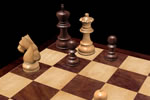


ChessBase 17 - Mega package - Edition 2024
It is the program of choice for anyone who loves the game and wants to know more about it. Start your personal success story with ChessBase and enjoy the game even more.
"Aw. c'mon. Don't be so hard on yourself. It happens to everybody sometime or another."
"Not to me, it doesn't."
It sounds like a bad Viagra commercial, but it's not. It's a "chess thing", trust me.
It's been like a gypsy curse with me lately (no disrespect to my friend Gypsy intended, by the way). Over the past few weeks I've played several games which have a recurring theme. I crack open my opponent's castled position (assuming they've castled at all) and chase their King out into the middle of the board. There follows an extended King hunt, which later analysis proves to be entirely unnecessary. I discover later that I've missed a mate-in-one sitting right there on the board while the opposing King's in the center, a mate usually achieved by a Knight move. And it hasn't happened just once, but several times over the last few weeks.
"It happens to everybody sometime or another."
"Not to me, it doesn't."
No, it's not that. It's something worse -- chess blindness.
I'll admit, I hit the panic button pretty hard there for a while. I realize that I'm getting older and all that, but there's really no excuse for missing a mate which is sitting right there on the board. Is it time to hang chess up and take up bridge or shuffleboard? Hey, I'm not that old (yet).
What's required here is training. As I was casting about for a solution to my dilemma, I suddenly remembered an old ChessBase trick that I'd not used in a long time. It's insanely easy to use and requires nothing more than the ChessBase program and a big ol' honkin' database of games; no special training software is required.
Just fire up ChessBase and double-click on the icon for a big database of games. This'll work on any database, but to get a lot of search "hits" you'll want to use the Big or Mega Databases, the Opening Encyclopedia, the Correspondence Database, or some similar large database. After you've opened the game list for the large database of your choice, click the button at the top of the screen which brings up the Search mask (the mouse rollover will read "Use the Search mask as filter in this game list").
After bringing up the Search mask, click the "Reset" button located near the bottom between the "Help" and "Cancel" buttons; this will clear the criteria you might have entered for a previous search. Next click the box next to the word "Mate" (in the "Result" section of the Search mask) to put a check in it, and then click "OK".
The ChessBase software will then start searching games to find the ones which ended in checkmate. When the search is over, your game list will show just the games which ended in mate. You can load a game just by double-clicking on it.
Now here's where the beauty of the thing really kicks in. When you double-click on a game to load it, the ChessBase program doesn't load the game at the final position -- instead it loads the game one move before the final position. Bingo! Instant mate-in-one training exercise. The mate is right there on the board; all you have to do is find it.
Here's another trick which makes the exercise even better. Click on the "Training" tab at the top of the Notation pane. The pane changes to hide all of the game's moves except the one which was just played. This is significant, not because you need to know the specific move, but because you need to know whose turn it is to move. So when you hit "Training" and you see that the last move was made by White, you know that Black has a mate-in-one sitting on the board.
Now you can make a move. It's easy to know whether or not you were correct -- if it's a mate, the new move displayed in the Notation pane will have the "#" symbol after it. No "#", no mate, as simple as that. If you make a move other than the one which was actually played, you'll see the popup for "New variation", "Overwrite", etc. It's worthwhile to choose "New variation" rather than immediately cancelling out of it; it's possible that there's more than one mating move and you found one that the actual player didn't play.
After solving the mate, hit F10 to load the next game from the list. The Notation pane will still be set to "Training" (so you won't have to fool with it again), and the pane will display the side which just moved. You just solve this position and then hit F10 to load the next position. It's fast, it's fun, and it's a whole lot better than taking some pill. As you're solving these problems, you're simultaneously improving your chess vision and curing that bad case of chess blindness which we all seem to develop from time to time.
One more keyboard trick: if you prefer to solve "Black to mate" problems while looking at the board from Black's perspective, hitting CTRL-F flips the board (i.e. rotates it 180 degrees so you're looking at it from the other player's perspective). If the next problem is a "White to mate" just hit CTRL-F to flip the board around again.
Until next week, have fun!
You can e-mail me with your comments on ChessBase Workshop. All responses will be read, and sending an e-mail to this address grants us permission to use it in a future column. No tech support questions, please.